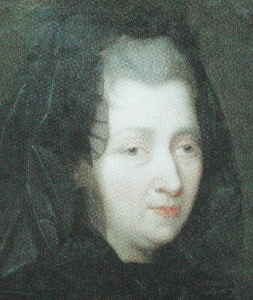Biography of Madame Guyon 1648 – 1717

Madame Guyon was an out-of-the-ordinary woman, persecuted and forgotten, but rediscovered in our time as being one of the greatest mystics of Christianity.
Married to someone she had not chosen and the mother of five children, Madame Guyon would remain a layperson. She would come to a state of inner union that nothing could corrupt and would discover that it was possible for her to transmit that state. She would thus feel called to apostolic life, that is to say to becoming a spiritual master; her radiance would spread beyond boundaries, in Catholic circles, but also in Protestant ones.
Jeanne-Marie Bouvier de la Motte was born in Montargis, France on April 13, 1648, into a noble, affluent, and devout family. She was the issue of a late second marriage. At her premature birth, Jeanne-Marie was given up for dead; she would later see being snatched from death as a sign of her inner path. She would also experience serious health problems throughout her life.
She was strongly attracted to devotion at a very young age, she was enthused by the life of Jeanne de Chantal, disciple of Francis de Sales and who would leave behind her eighty-seven monasteries across the whole of Europe. She was married, when she was not yet sixteen, to someone she did not know, twenty-two years her senior, whom she had not chosen, and whom she would not see until three days before the ceremony; this was a common destiny for girls at that time. Her husband, although loving, was a temperamental man; her mother-in-law was a sour-tempered and miserly woman who blighted her life.
After her second child, when Jeanne was nineteen, an encounter would be decisive for her inner life. A monk she consulted about her difficulties praying silently told her, “It is, Madam, because you seek without what you have within. Accustom yourself to seek God in your heart, and you will there find Him.”
Madame Guyon then set herself to the practice of silent prayer for four hours a day. She gave birth to five children, lost two. “After twelve years and four months in the crosses of marriage,” she found herself a widow with a considerable income.
Madame Guyon entered into a period of inner darkness that would last five years “without a moment of consolation” (1675–1680). That inner desolation would suddenly give way to a state of “perfect life,” when she was thirty-two.
She had the feeling that she ought to go to Geneva, the diocese of Francis de Sales, canonized in 1665, and capital of the Protestant Reformation. It was there that Jane Frances de Chantal had begun her work. The bishop of Geneva, who hoped for a donation, asked her to become the prioress of the New Catholics, an institution designed to educate young Protestants who had converted—having sometimes been forcibly removed from their parents. Madame Guyon was not convinced of the value of these methods to bring “heretics” back to the “true religion.” She left for Thonon where she founded a hospital. She started writing and discovered that she could transmit something of her inner state to others, first to father Lacombe, her confessor, then to other persons who were touched by her spiritual influence.
Madame Guyon then found herself in a precarious situation; some clergymen were displeased with her and, having no friends in high places, she would find herself drawn, despite herself, into a theological dispute that was a pretext for struggles over influence and power.
She came back to Paris in 1686, she was thirty-eight years old, just before the condamnation of Molinos, a priest in Roma, for his writings regarded as heretic. Some priests, jealous of father Lacombe accused him of being a “friend of Molinos,” they would finally get him arrested in October 1687. Father de la Motte, madame Guyon half-brother’s, who wanted her consenting to a marriage of her daughter to the dissolute nephew of the bishop of Paris, succeeded in having her imprisoned at the beginning of 1688, in a convent where everyone had been warned against her. After nine months, when the case seemed hopeless and she was about to be sent, by her enemies, to a prison for life, the king ordered her liberation—thanks to Madame de Maintenon (who married secretly the king).
It was at that time that she met Fénelon, the most famous of her disciples. She exerted her spiritual radiance at the court of Louis XIV. She was forty-seven years old when begins from the summer of 1693 a second and long period of trials. Her writing: The Short and Easy Method of Silent Prayer unanimously appreciated was now accused of reflecting the positions of Molinos. After having praised her, Madame de Maintenon wanted to get rid of her with the help of Bossuet, the famous Bishop of Meaux. Madame Guyon was finally arrested and taken first to Vincennes in 1695, then to the Bastille. She would be released on a stretcher in 1703 after having undergone several poisoning attempts.
After she was released from prison, Madame Guyon lived and wrote quietly at Blois. She began to correspond with an international following of like-minded mystics, especially in England, Scotland, the Netherlands, and Germany. Although she continued to correspond with Catholics, many of whom were friends and supporters (including Fénelon, with whom she communicated in secret), she also gained a following among Protestants. Her biblical commentary influenced German mysticism, and her mystical writings were widely translated and anthologized by other Protestant groups, particularly the Society of Friends (Quakers). Her writings were originally published from 1712 to 1720 (45 vol., reprinted 1767–90).
